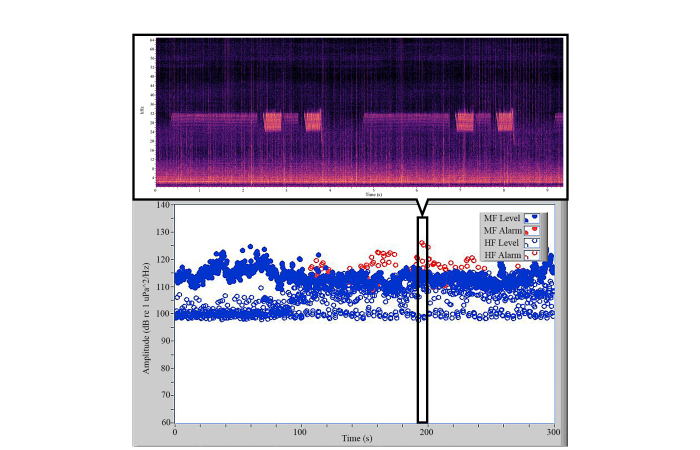Beneath the surface in the San Diego Bay, a group of bottlenose dolphins communicate through a series of high-pitched whistles. These whistles are more than just sounds. They are vital for the dolphins’ survival. Whistles are important for social interactions like individual identification, mother-calf bonding, and for keeping the pod together. But human activities create a din that could potentially disrupt these vital conversations. The NMMF’s latest study, in collaboration with the U.S. Navy’s Marine Mammal Program, reveals a fascinating insight: these dolphins can maintain their communication despite the noise from human activity.
To understand how these dolphins cope with noise, our research team embarked on a groundbreaking study. Using cutting-edge technology, they deployed a specialized array of hydrophones in the San Diego Bay, known as the Welfare Acoustic Monitoring System (WAMS), with the goal of studying the vocal behavior and welfare of the Navy’s dolphins. For over three years, they meticulously recorded and analyzed the whistle rates of 20 dolphins to see if the clamor of human activity, including boats, sonar, offshore construction, and more, impacted the dolphins’ ability to communicate.
Despite the noise from vessels and other human activities, the dolphins’ whistle rates remained remarkably consistent. The research showed that these intelligent marine mammals continued their vocal exchanges without missing a beat, even during noisy events.
The hydrophones captured everything, from typical underwater noise to the loudest vessel traffic, providing a rich dataset for analysis. What the team found was both surprising and encouraging: the dolphins were not significantly altering their communication patterns due to the noise.
Our advanced acoustic monitoring methods record bottlenose dolphins around the clock, allowing us to gain insight about their vocal behavior and welfare. The Welfare Acoustic Monitoring System (WAMS) is a window into their world, recording their sounds day and night.

When the environment gets noisy in the San Diego Bay, our acoustic monitoring system picks up on it! The spectrograms we created show us the different noise events, but even in the midst of human activity, the dolphins kept up their chatter. The top figure depicts a noise event, while the bottom figure depicts how loud the noise is (red dots) compared to typical bay noise (blue dots).
Check out these whistle rates! The blue bars show dolphin whistles 5 minutes before a noise event and for the first 5 minutes of the event. The green bars show whistle rates during the entire noise event and in periods without noise. The consistency is remarkable!
Ever wondered how we study dolphin communication? Watch as a noise event starts and we manually count the dolphin whistles. This detailed analysis helps us understand how these amazing animals adapt to noisy environments!
Understanding how human activities impact marine life is crucial. Our study suggests that, at least in this case, bottlenose dolphins are more resilient than we might have thought. Moderate noise levels didn’t stop them from communicating, which is a hopeful sign for their adaptability.
However, this doesn’t mean we should be complacent. Noise pollution remains a significant concern, and we must continue to monitor and regulate it to protect all marine life. Our findings provide a piece of the puzzle, helping inform policies and conservation strategies to ensure marine life continues to thrive.
For those interested in reading more, you can find the full details of the study in the Journal of Marine Science and Engineering. It provides comprehensive information on how we conducted our research and what we discovered.
We invite you to follow our journey and stay updated on our latest research and conservation efforts. By understanding and sharing knowledge about marine life, we can all contribute to protecting the incredible diversity of our oceans.
Stay connected with us on social media! Facebook & Instagram: @NMMFoundation
Sign up for our newsletter and stay informed on our latest findings.
Let’s work together to ensure a future where the songs of the dolphins continue to fill our oceans, no matter how noisy the world above becomes.
Read the latest journal entry from NMMF.
Help us to improve and protect the life of all marine mammals, humans, and our shared oceans.
Join our newsletter to hear the latest NMMF news.
National Marine Mammal Foundation is a registered 501(c)(3). Tax ID: 26-1501109 | Copyright 2023
Field photography taken under MMPA/ESA Permit No 18786-1 | No images or content may be shared, replicated or used without written consent from the National Marine Mammal Foundation.
Privacy Policy & Terms and Conditions